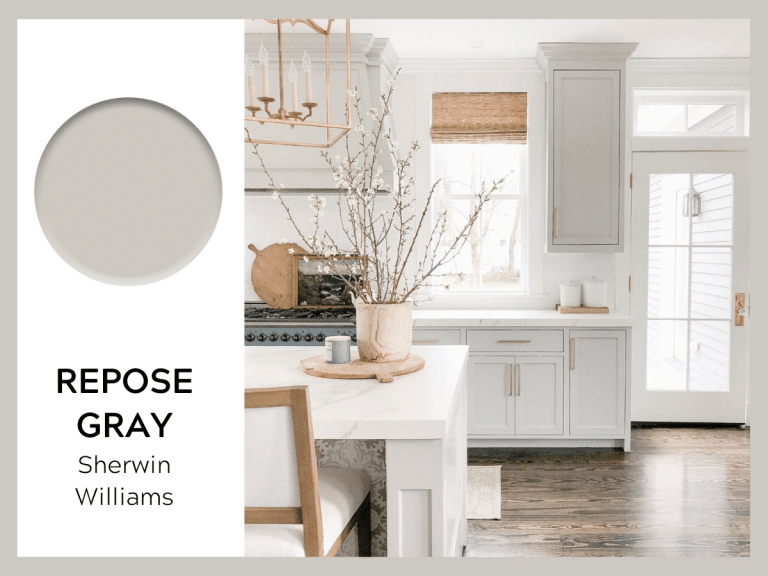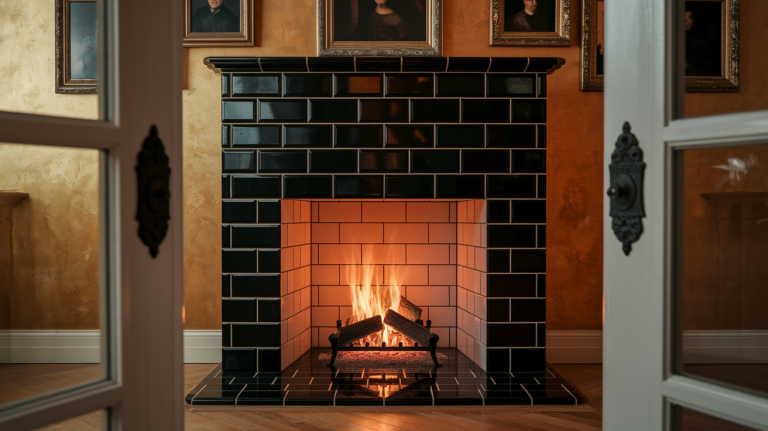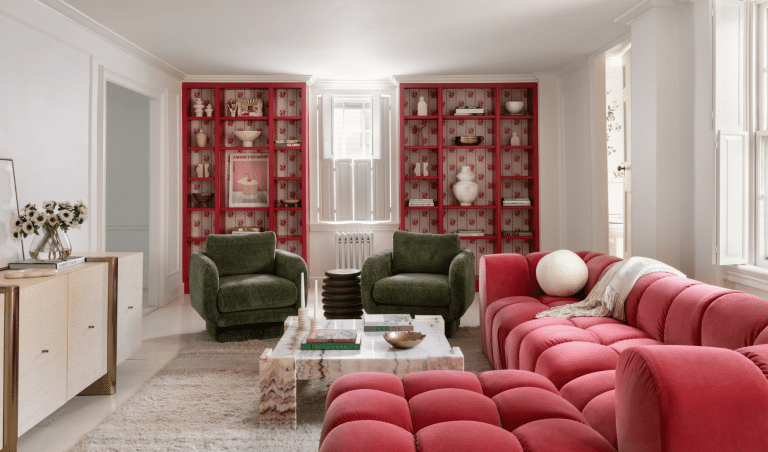11 Best Vases for Tulips for Your Home
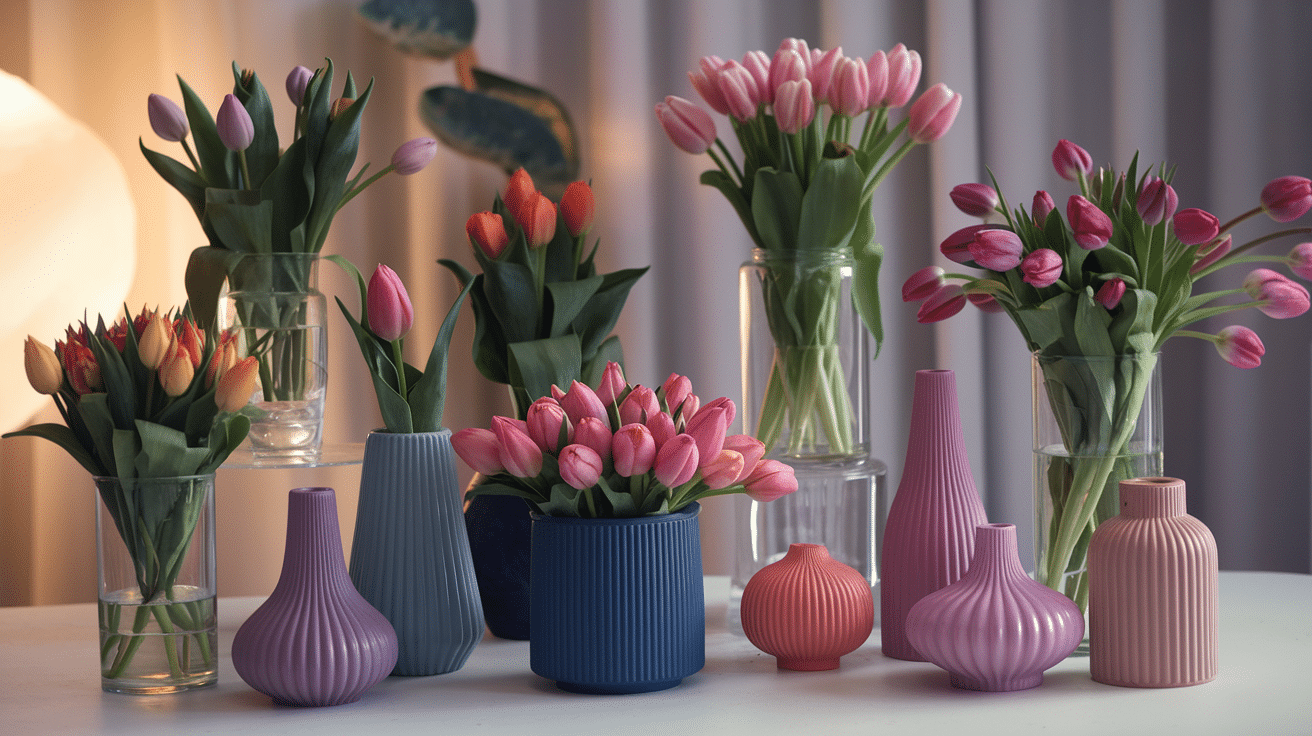
Do you love tulips but find they often droop or flop in your vase? The right kind of vase makes all the difference in showing off these spring favorites.
Finding the perfect vase for tulips isn’t just about looks; it’s about supporting their continuing growth and movement. The right choice helps tulips stay fresh longer while looking their best.
This guide will help you pick the ideal vase for your tulips, whether you have a mixed bouquet or a simple bunch of a single color.
What is a Tulip Vase
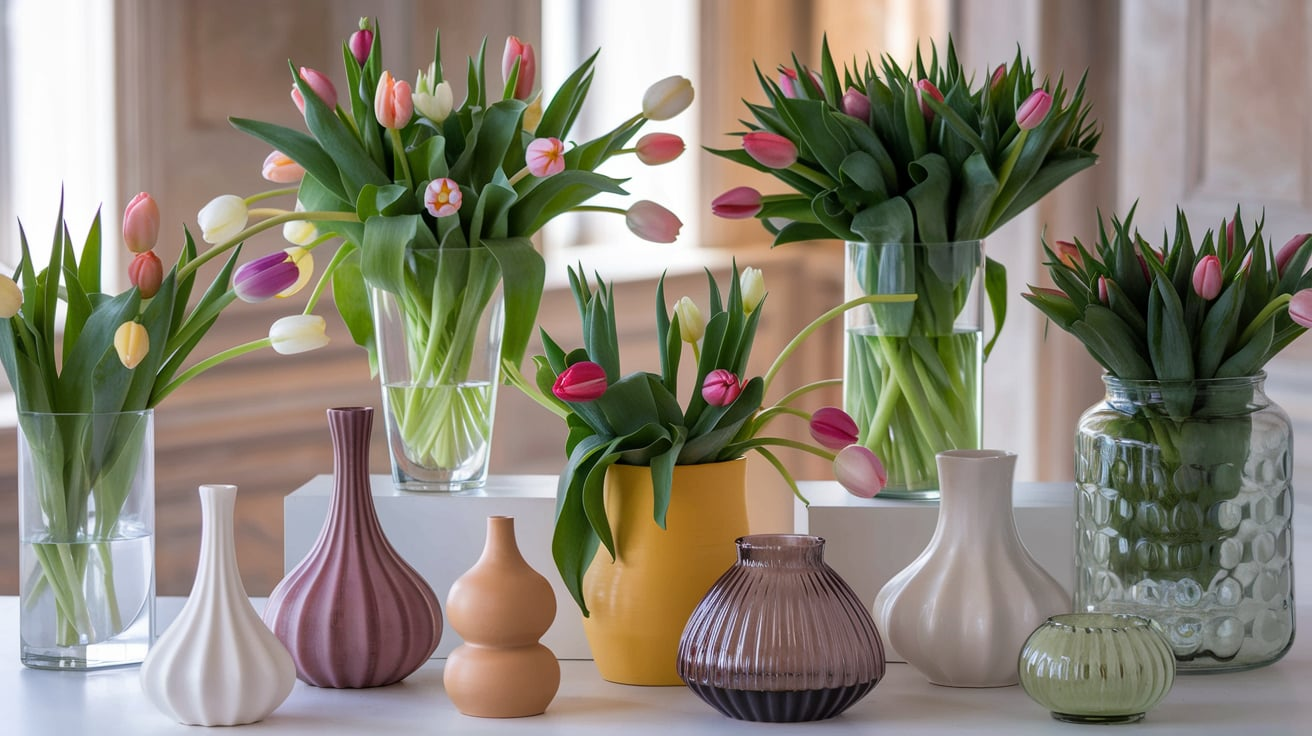
Tulip vases come in various shapes and sizes, but they all share certain features that make them perfect for these spring flowers.
Unlike regular flower vases, tulip vases are designed with the unique growth habits of tulips in mind.
The most common tulip vase has a narrow neck that widens at the top. This shape supports the stems while allowing the flowers to spread naturally.
A tulip vase typically stands 6 to 10 inches tall, tall enough to support the stems but not so tall that the flowers look lost.
How is It Different from Other Vases
| Feature | Tulip Vases | Standard Vases |
|---|---|---|
| Neck Design | Narrowed neck to keep stems together | A wide opening that may cause flowers to spread |
| Height | Shorter profile, focuses on blooms | Taller, often used for taller flowers like roses |
| Shape | Curves or bends to mirror tulip stems | Generally straight or slightly curved |
| Water Capacity | Holds less water, just enough for tulips | Often holds more water, suitable for other flowers |
| Stem Support | Keeps tulips from splaying out | May cause stems to spread or droop |
List of Best Vase for Tulips You Can Try
Several styles of tulip vases exist, each offering unique benefits for displaying these beloved spring flowers.
Here’s a look at the most common types:
1. Hourglass Vases
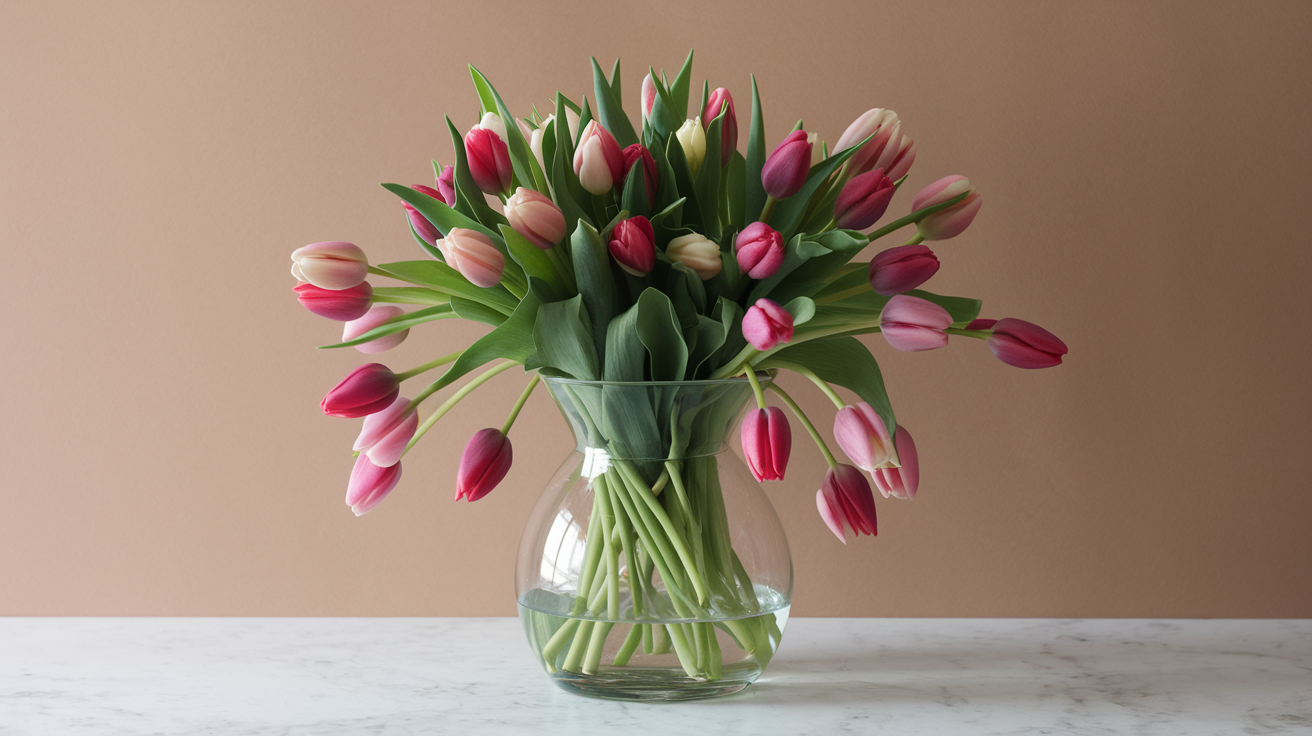
Hourglass vases feature a narrow middle and a wider top. This shape naturally gathers stems at the center while allowing blooms to spread at the top.
The design works perfectly with tulips’ tendency to grow and move after being cut.
2. Tulipiere Vases
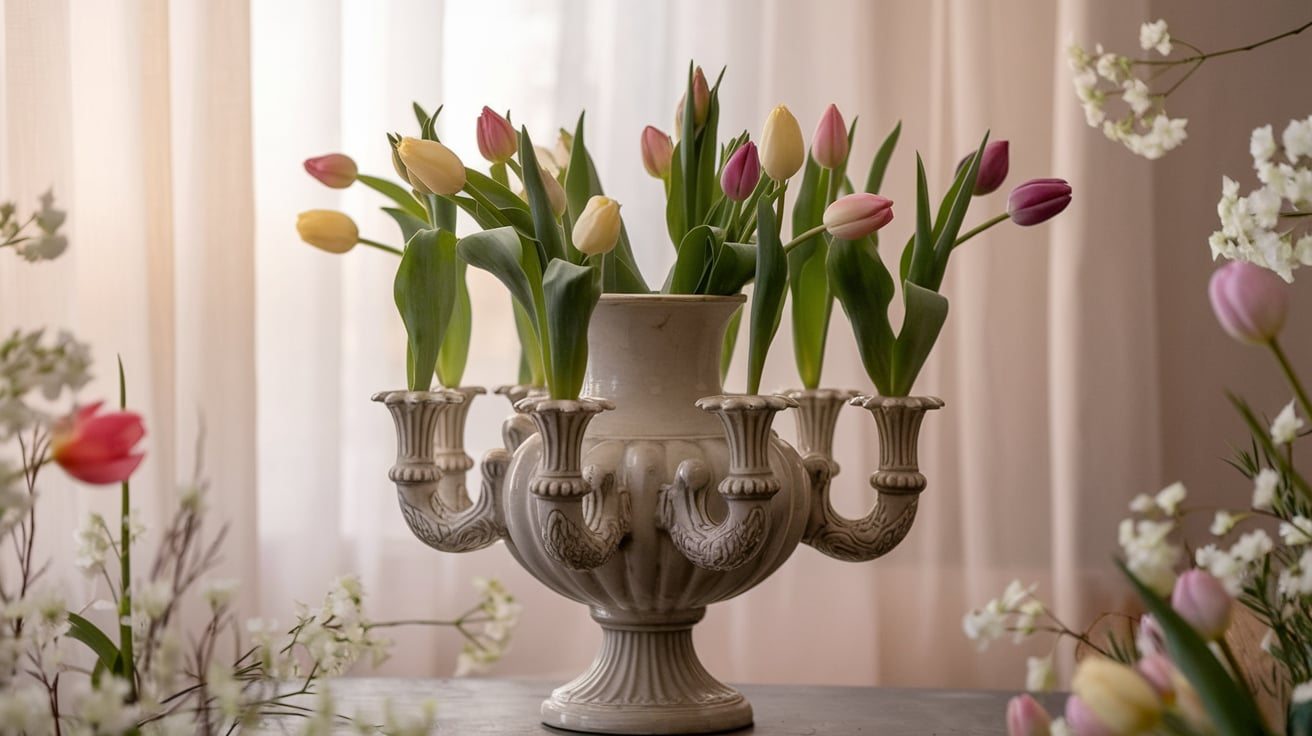
Tulipiere vases come from Dutch tradition and have multiple spouts branching from a central vessel.
Each opening holds a single stem, creating a formal, structured display. These vases work beautifully for spacing out different colored tulips.
3. Bulb Vases
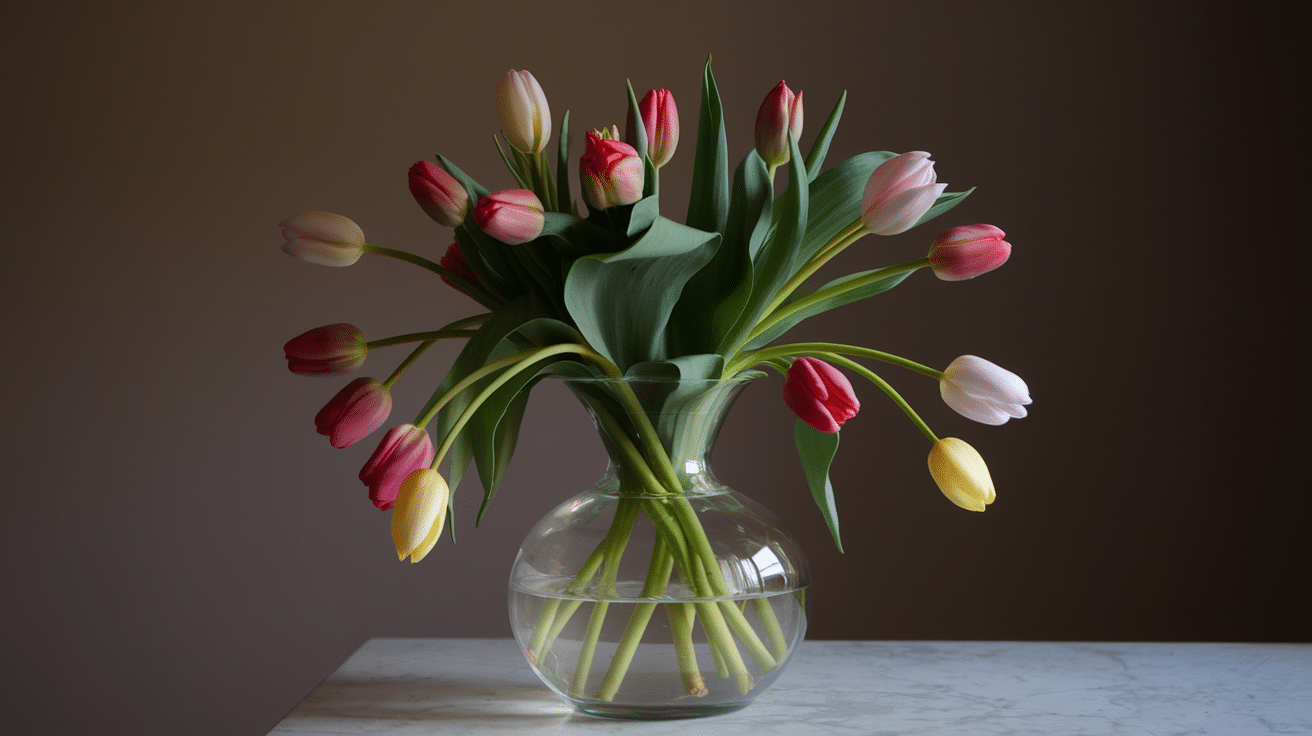
Bulb vases feature a distinctive shape with a round bottom that tapers to a slender neck, perfectly cradling tulip stems.
This design, once used to grow bulbs in water, now serves as an ideal display for cut tulips by providing natural support that prevents flopping.
The curved glass shows off the entire tulip – from the water-submerged stems to the colorful blooms – creating a complete visual story highlighting the whole flower.
4. Flared Vases
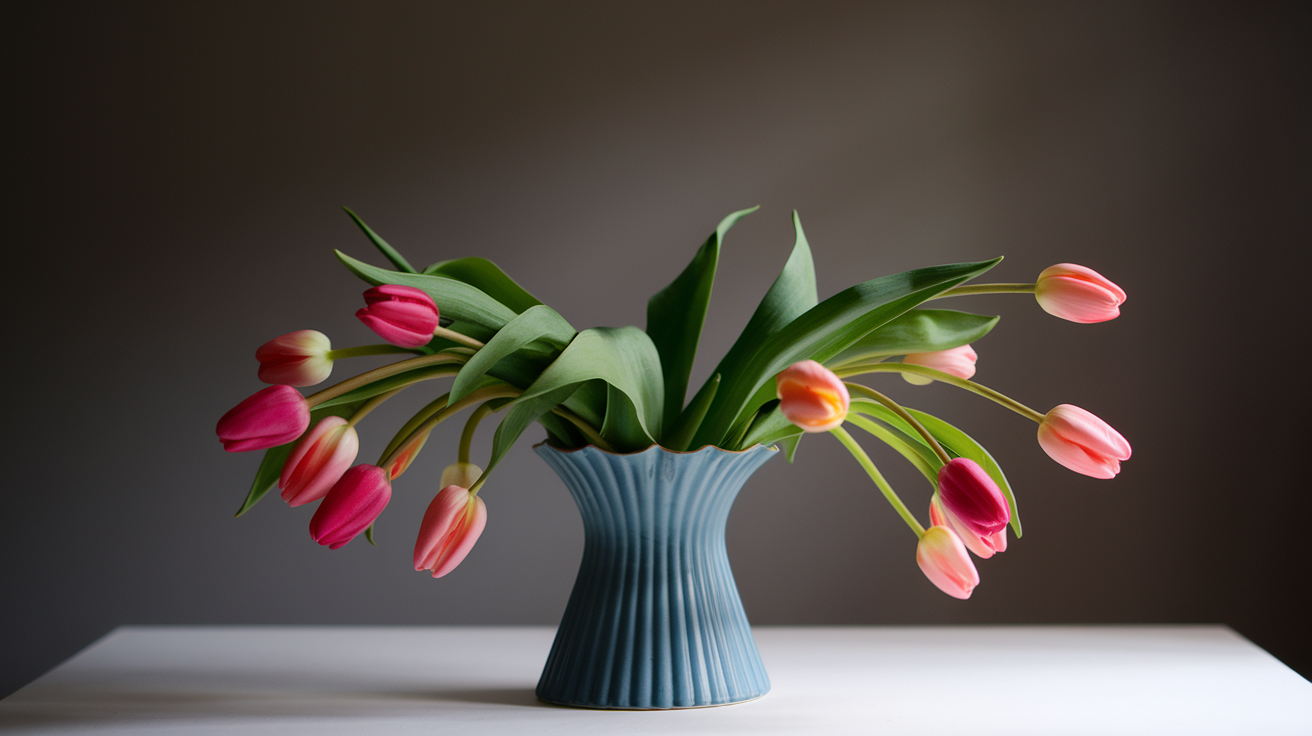
Flared vases expand gracefully toward the top, creating the perfect space for tulips to spread their stems and bloom naturally.
The wider opening accommodates the tulips’ tendency to continue growing and bending toward light after cutting, turning what might look untidy in other containers into an intentional, artistic display.
These vases work particularly well for larger tulip bunches, giving each flower enough room to open fully while providing structure at the base.
5. Straight Cylinder
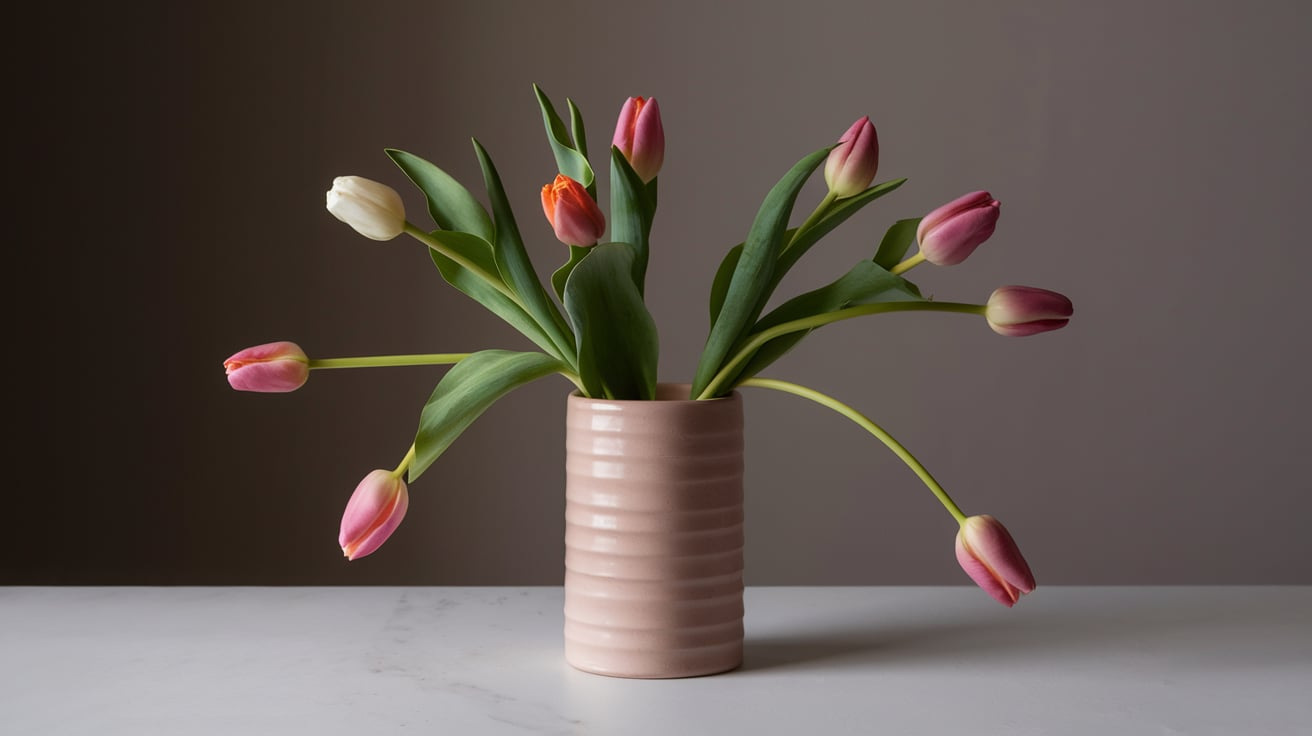
Straight cylinder vases create a clean, unfussy backdrop that lets tulips shine as the show’s star. Their simple vertical lines provide just enough structure without drawing focus away from the flowers themselves.
These versatile vases work with many design styles, from casual country to sleek contemporary, making them a practical choice for displaying tulips in any room.
6. Bubble Vases
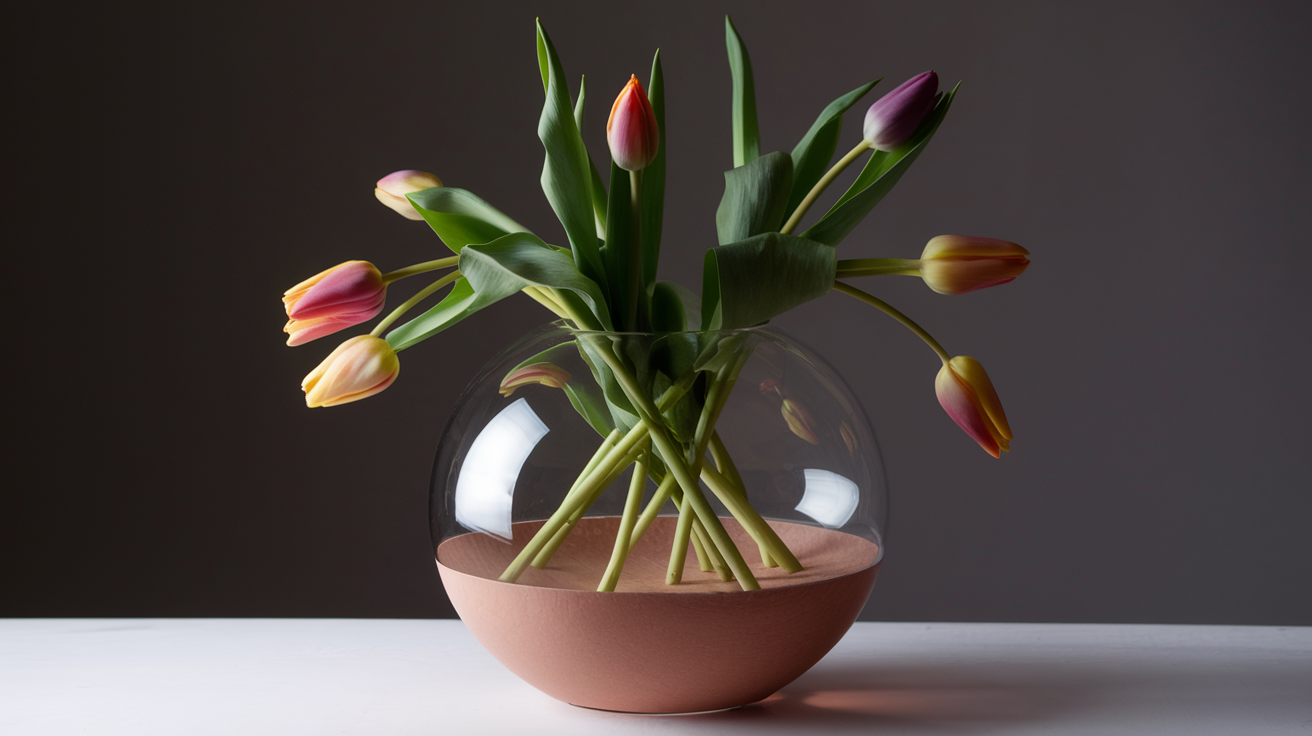
Bubble vases capture attention with full, rounded bases that taper toward a smaller opening at the top.
This playful shape creates a sense of visual balance by contrasting the round, weighted bottom with the upward-reaching tulip stems.
The narrower neck naturally gathers tulips into an attractive bunch, while the heavier base prevents tipping, even when filled with a generous arrangement of flowers.
7. Bud Vases
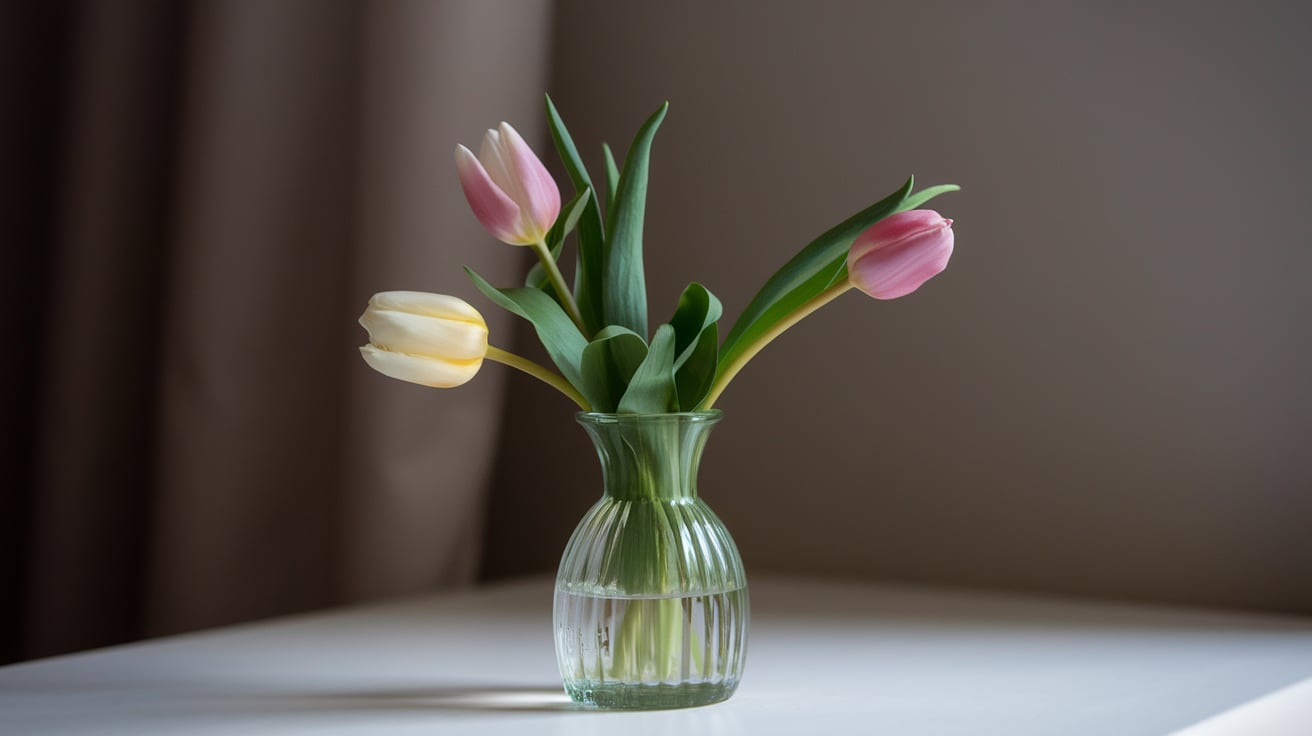
Bud vases create charming, understated displays that celebrate the beauty of just a few tulips at a time.
Their petite size makes them perfect for small spaces where larger arrangements might overwhelm, such as nightstands or narrow shelves.
These dainty vessels come in countless shapes and materials, allowing for creative placement throughout the home in unexpected spots that add touches of color and life.
8. Trumpet Vases
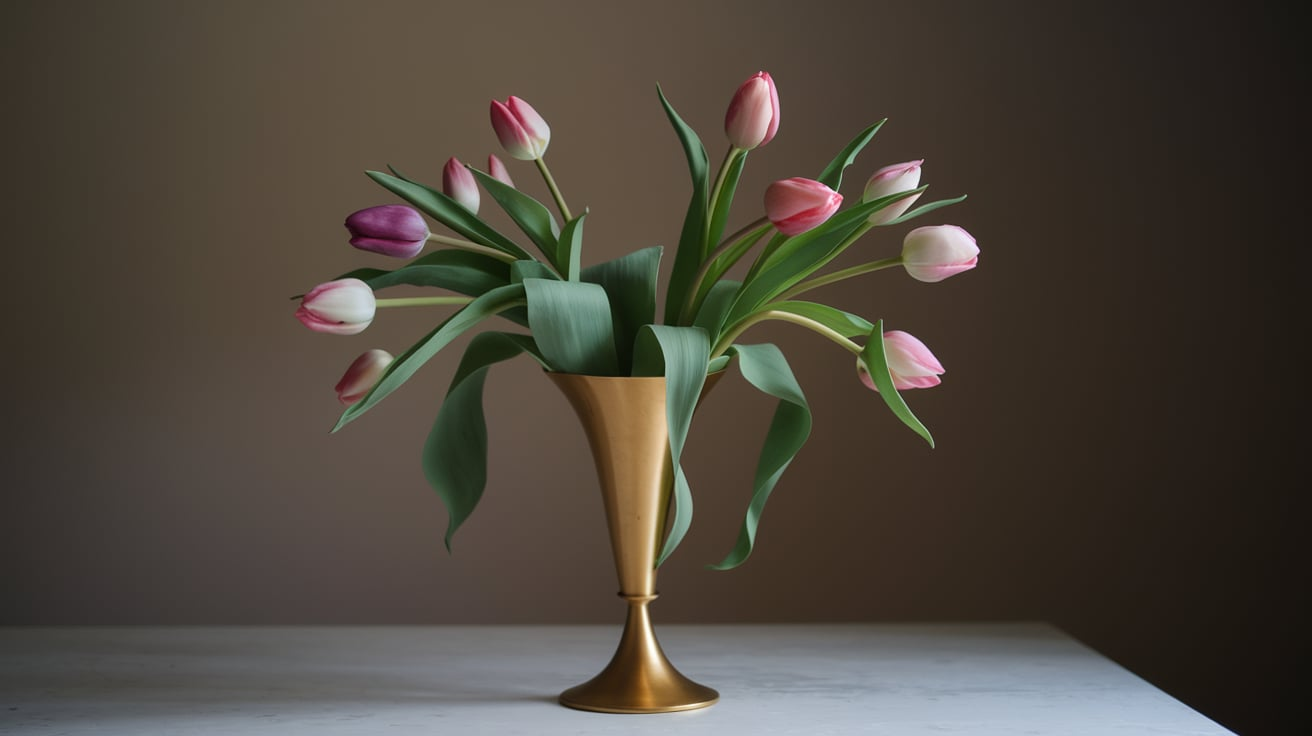
Trumpet vases mirror the shape of tulips themselves with their gradually widening profile that opens at the top.
Their narrow bases provide excellent stability, while the broader upper section creates the perfect space for tulips to fan out in a natural, sun-like pattern.
This harmonious shape works with the flowers rather than against them, guiding stems into an attractive, effortlessly arranged formation.
9. Cube Vases
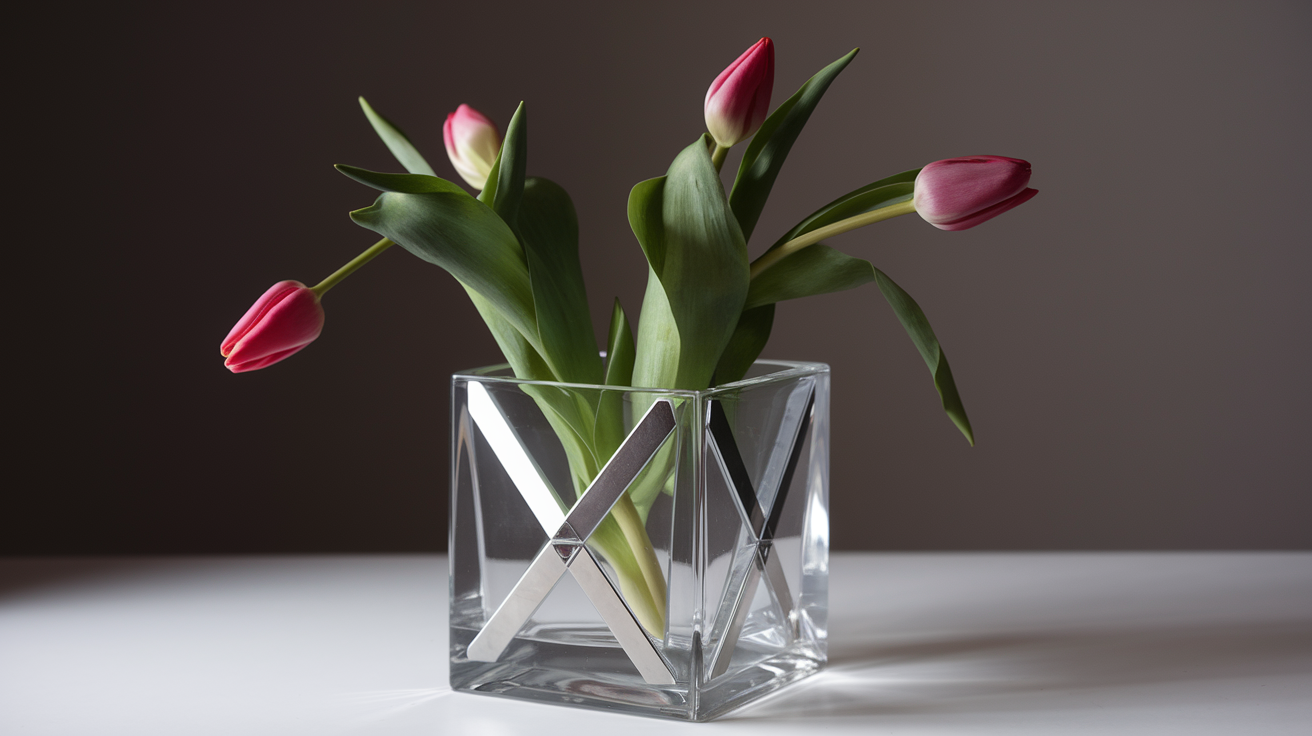
Cube vases contrast strikingly with tulips by pairing sharp geometry against soft, organic flower shapes.
Their straight edges and right angles highlight the gentle curves of tulip stems and petals, drawing attention to both elements.
This visual tension works especially well in modern spaces, where the vase’s clean lines complement minimalist decor while letting the flowers’ natural beauty take center stage.
10. Hurricane Vases
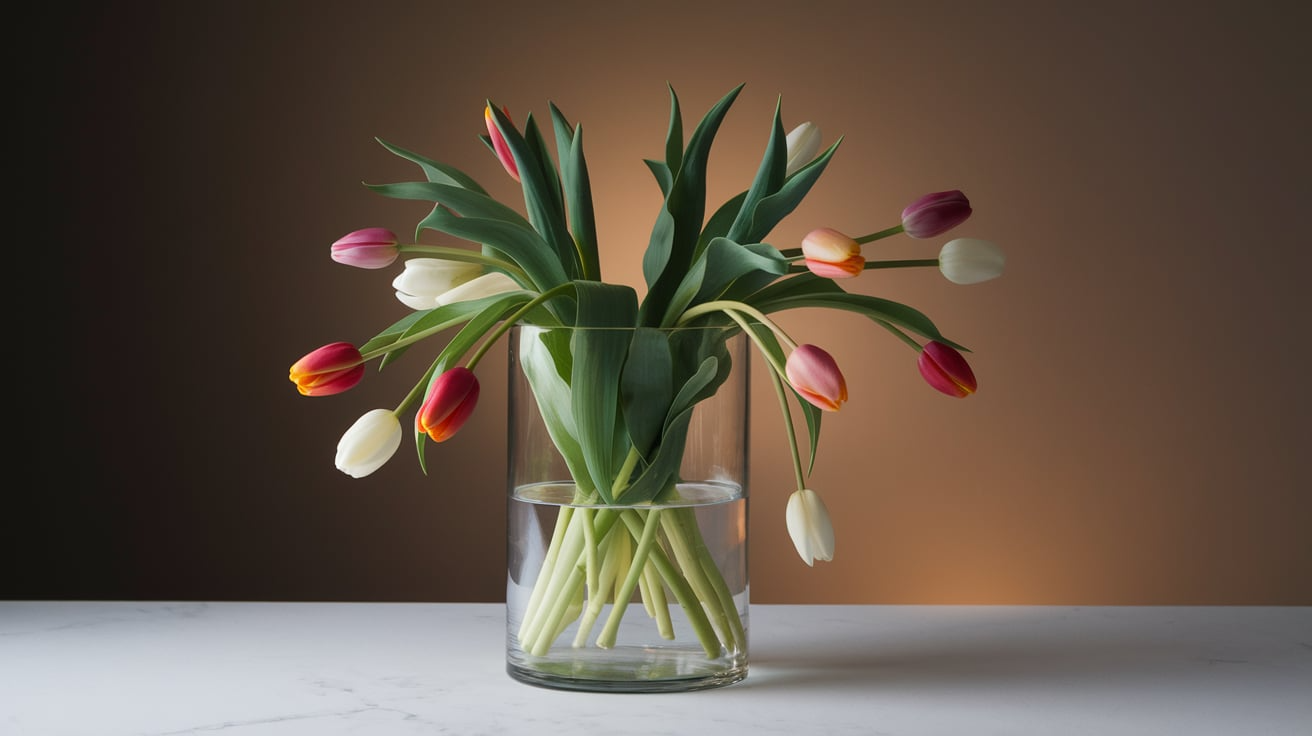
Hurricane vases offer practical benefits for tulip displays with their sturdy, weighted construction that handles even the tallest stems without wobbling.
Their thick glass walls add a sense of substance to the arrangements while allowing full visibility of the water and stems inside.
The inward-curving lip found on many hurricane vases is a natural guide that keeps tulips gracefully positioned rather than splayed outward, creating more structured arrangements with minimal effort.
11. Ginger Vases
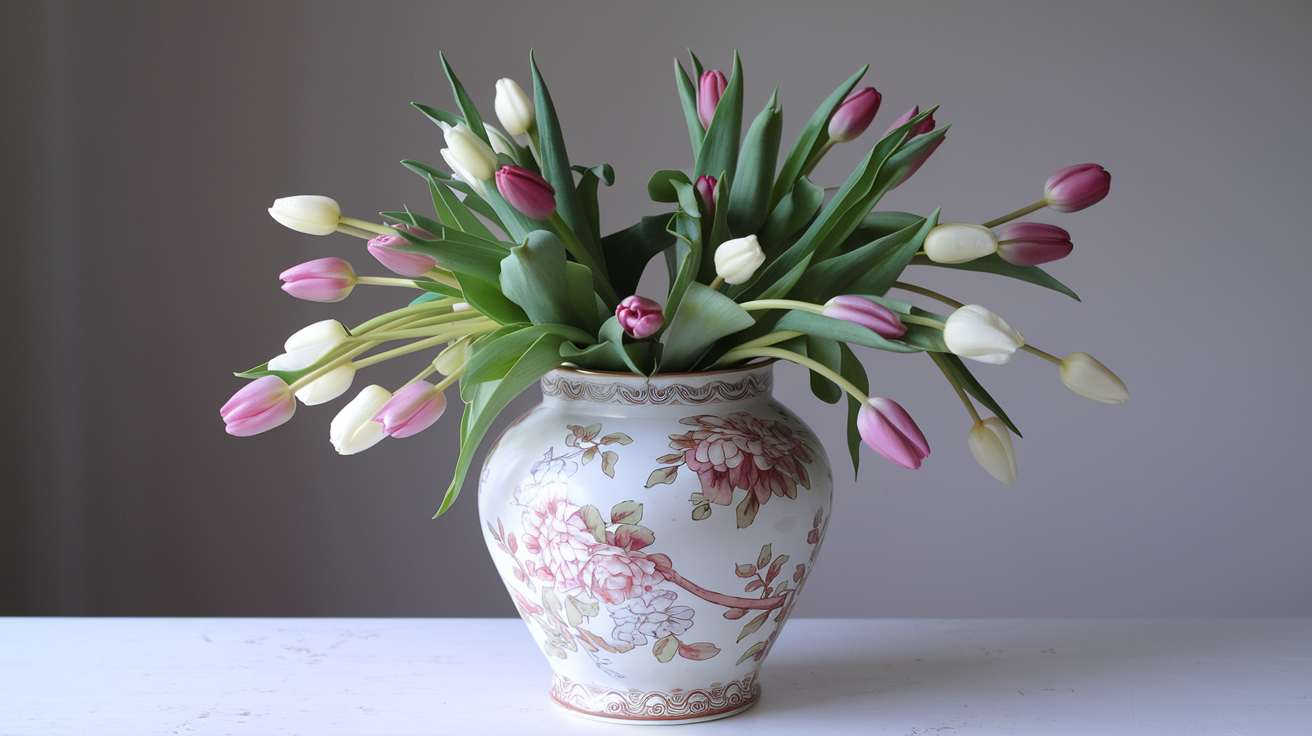
Ginger jar vases bring decorative flair to tulip arrangements with ornate bodies often featuring patterns or colorful glazes.
Their wide, rounded shape, paired with smaller openings, naturally gathers tulip stems into an attractive bunch without additional arranging.
These traditional vessels create a beautiful balance between formal and casual, making them suitable for special occasions and everyday enjoyment throughout the tulip season.
How to Arrange Tulips in a Vase
- Step 1: Arranging tulips properly helps showcase their natural beauty and extends their vase life.
- Step 2: Start with fresh tulips that show color but aren’t fully open, as flowers that are too open won’t last as long.
- Step 3: Trim the stems at a 45-degree angle, about an inch from the bottom, which helps tulips drink water more easily.
- Step 4: Remove any leaves that would sit below the water line to prevent rot.
- Step 5: Fill the vase with room temperature or slightly cool water, as warm water makes tulips open faster while cool water helps them last longer.
- Step 6: Add a floral preservative or a teaspoon of sugar to feed the flowers. Some people add a copper penny to the water as a natural antibacterial agent.
- Step 7: Arrange stems loosely with some space between them rather than cramming too many into the vase, as overcrowding reduces air circulation.
- Step 8: Since tulips bend toward light sources, rotate the vase daily to keep the arrangement balanced instead of lopsided. Keep your arrangement away from fruit bowls, as fruit releases ethylene gas, which speeds up flower aging.
Approximate Cost Variation
| Vase Type | Estimated Cost (Low End) | Estimated Cost (High End) | Details |
|---|---|---|---|
| Tulip Vase | $15 | $40 | Narrowed neck to keep tulips together and prevent them from splaying out. |
| Tulipiere Vase | $50 | $150 | Traditional Dutch design with multiple spouts for a formal, structured tulip display. |
| Bulb Vase | $20 | $50 | Round bottom and narrow neck, originally for forcing bulbs but also great for tulips. |
| Straight Cylinder Vase | $10 | $30 | Simple and modern design, with clean lines that complement tulips without competing for attention. |
| Flared Vase | $25 | $60 | Wider mouth at the top, allowing tulips to spread and bend naturally toward light. |
| Bubble Vase | $20 | $55 | A rounded bowl-like base with a narrower opening creates stability and contrast with angular tulip stems. |
| Bud Vase | $10 | $25 | Small, slender vase, perfect for one to three tulips in intimate arrangements. |
| Trumpet Vase | $30 | $75 | The narrow base widens toward the top, mimicking the shape of a trumpet for stability and spread. |
| Cube Vase | $20 | $50 | Modern geometric design with straight lines and right angles for contrast with tulip curves. |
| Hurricane Vase | $30 | $80 | Cylindrical shape with substantial weight to prevent tipping, with some featuring a curved inward lip. |
| Ginger Jar Vase | $40 | $100 | Wide body with a smaller opening, naturally gathering tulip stems while adding decorative interest. |
Certain Tips to Care for Tulip Vases
Keeping tulip vases in good condition will bring joy for many seasons. With proper care, these special vases last for years:
- Clean thoroughly after each use. Wash any flower residue with mild soap and warm water. For stubborn stains, try a vinegar and water solution, then rinse well.
- Use a bottle brush for narrow openings. The slim necks of tulip vases can be hard to clean. A long, flexible brush helps reach those tight spots where bacteria might grow.
- Avoid harsh chemicals. Strong cleaners can damage the finish on ceramic or glass vases. Gentle cleaning products keep vases looking their best.
- Store carefully when not in use. Keep vases in a cabinet or shelf where they won’t get knocked over. For delicate or antique pieces, consider wrapping them in a soft cloth.
- Check for cracks regularly. Small cracks might lead to leaks. Inspect vases before filling them with water to avoid surprises on your furniture.
- Use soft water when possible. Hard water can leave mineral deposits on glass vases. Filtered water helps prevent these cloudy marks.
- Handle with dry hands. Wet hands might cause slipping, especially with glass vases. Always grip with clean, dry hands to prevent accidents.
Conclusion
Choosing the right vase makes all the difference when displaying tulips. The proper container showcases their beauty and extends their lifespan.
Remember that tulips continue growing and moving after cutting, so their ideal vase should accommodate this natural behavior.
Why does this matter? Because tulips deserve to be shown at their full potential. Their brief blooming season becomes more enjoyable with the right presentation.
Share your favorite tulip vase types in the comments below!
Frequently Asked Questions
How Much Water Should be Added to a Tulip Vase?
Fill the vase about one-third full. Tulips don’t need deep water, and too much can speed stem decay. Change the water every 2-3 days to keep the flowers fresher longer.
Do Tulip Vases Work for Other Flowers?
Yes! Tulip vases work wonderfully for daffodils, hyacinths, and other spring bulb flowers with similar growth habits. The narrow neck provides good support for many flower types.
How Do You Clean a Tulip Vase with a Very Narrow Neck?
Use a bottle brush or add warm water, vinegar, and a few rice grains. Swirl the mixture around to help scrub the inside walls, then rinse thoroughly.


